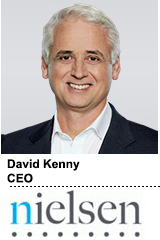 Nielsen will split into two separate public companies, breaking apart its Watch media measurement and metrics business from Connect, which provides market share analytics and attribution in the CPG and retail category.
Nielsen will split into two separate public companies, breaking apart its Watch media measurement and metrics business from Connect, which provides market share analytics and attribution in the CPG and retail category.
The decision, announced during the company’s Q3 earnings report Thursday, comes after a yearlong strategic review, where Nielsen considered sales offers or other spinoff and exit opportunities. In the end, the board decided Nielsen’s most effective path forward was as two independent companies.
The restructure is expected to take nine months to a year to close, and CEO David Kenny will lead Nielsen Watch. The company is conducting a search for a new CEO of the Connect business.
Despite not closing a deal during the strategic review period, Nielsen’s decision doesn’t preclude a sale, and may even catalyze an acquisition of one or both of the businesses.
One of the barriers to a potential Nielsen sale was the company’s $8.5 billion debt, which will not be evenly distributed across both new companies. The less indebted (and faster growing) Watch business could be more attractive as a stand-alone asset.
The media measurement group grew almost 4% year over year to $870 million in Q3. The Connect business decreased by 2.2% to $746 million.
The businesses are also more efficient and will have higher growth potential operating separately, Kenny told investors.For years, Nielsen and clients pursued a thesis that they could multiply marketing ROI by consolidating measurement for what people watch and what people buy, Kenny said.
That thesis didn’t entirely pan out because the verticals that needed the Watch data weren’t always the same verticals that needed the purchase data.
The retail and fast-moving consumer goods category (FMCGs, the global equivalent of CPGs) now make up only 9% of advertising, down from when household and grocery brands took the lion’s share of TV inventory, Kenny said. The Connect business’s focus on retail data meant that the Watch business was necessarily over-indexed to that category.
One of the big opportunities for Nielsen Watch as an independent unit will be its growth into categories like pharma, auto, finance and credit cards, and being less reliant on FMCGs, he said.
Watch will also look for more measurement opportunities beyond advertising. Kenny said many streaming services don’t support ads, but increasingly need OTT market share analytics and to understand how their own content performs and because there are so many new competitors in the space.
After the split, the two Nielsen companies will continue to have preferred partnerships and pricing for clients that use both, Kenny said. But the synergies stop there. The Watch group will partner with outside data providers if customers use other vendors to match media to store sales or other business outcomes.
Nielsen still hopes to transition its legacy media ratings to digital and streaming media.
Of course, Nielsen’s competitor Comscore is also pursuing this goal. And both companies are challenged in digital media traction when it comes to cross-channel audience ratings.
Comscore’s new CEO, Bill Livek, former CEO of Rentrak, told investors on his earnings report earlier this week that many broadcasters and publishers moving content online adopt programmatic methodologies and aren’t using TV currencies – instead linking buys to digital performance metrics.
Kenny said Nielsen is “pushing forward with digital initiatives” and sees a chance to be a comprehensive cross-platform audience rating.
“Only Nielsen can provide that at true currency quality,” he said.











